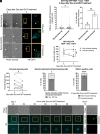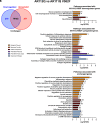Mutant androgen receptor induces neurite loss and senescence independently of ARE binding in a neuronal model of SBMA
- PMID: 38976730
- PMCID: PMC11260106
- DOI: 10.1073/pnas.2321408121
Mutant androgen receptor induces neurite loss and senescence independently of ARE binding in a neuronal model of SBMA
Abstract
Spinal and bulbar muscular atrophy (SBMA) is a slowly progressing neuromuscular disease caused by a polyglutamine (polyQ)-encoding CAG trinucleotide repeat expansion in the androgen receptor (AR) gene, leading to AR aggregation, lower motor neuron death, and muscle atrophy. AR is a ligand-activated transcription factor that regulates neuronal architecture and promotes axon regeneration; however, whether AR transcriptional functions contribute to disease pathogenesis is not fully understood. Using a differentiated PC12 cell model of SBMA, we identified dysfunction of polyQ-expanded AR in its regulation of neurite growth and maintenance. Specifically, we found that in the presence of androgens, polyQ-expanded AR inhibited neurite outgrowth, induced neurite retraction, and inhibited neurite regrowth. This dysfunction was independent of polyQ-expanded AR transcriptional activity at androgen response elements (ARE). We further showed that the formation of polyQ-expanded AR intranuclear inclusions promoted neurite retraction, which coincided with reduced expression of the neuronal differentiation marker β-III-Tubulin. Finally, we revealed that cell death is not the primary outcome for cells undergoing neurite retraction; rather, these cells become senescent. Our findings reveal that mechanisms independent of AR canonical transcriptional activity underly neurite defects in a cell model of SBMA and identify senescence as a pathway implicated in this pathology. These findings suggest that in the absence of a role for AR canonical transcriptional activity in the SBMA pathologies described here, the development of SBMA therapeutics that preserve this activity may be desirable. This approach may be broadly applicable to other polyglutamine diseases such as Huntington's disease and spinocerebellar ataxias.
Keywords: SBMA; neurite; senescence; transcription.
Conflict of interest statement
Competing interests statement:The authors declare no competing interest.
Figures








Similar articles
-
Enhanced aggregation of androgen receptor in induced pluripotent stem cell-derived neurons from spinal and bulbar muscular atrophy.J Biol Chem. 2013 Mar 22;288(12):8043-8052. doi: 10.1074/jbc.M112.408211. Epub 2013 Jan 30. J Biol Chem. 2013. PMID: 23364790 Free PMC article.
-
Pathogenesis and therapy of spinal and bulbar muscular atrophy (SBMA).Prog Neurobiol. 2012 Dec;99(3):246-56. doi: 10.1016/j.pneurobio.2012.05.007. Epub 2012 May 15. Prog Neurobiol. 2012. PMID: 22609045 Review.
-
Disrupting SUMOylation enhances transcriptional function and ameliorates polyglutamine androgen receptor-mediated disease.J Clin Invest. 2015 Feb;125(2):831-45. doi: 10.1172/JCI73214. Epub 2015 Jan 20. J Clin Invest. 2015. PMID: 25607844 Free PMC article.
-
Loss of endogenous androgen receptor protein accelerates motor neuron degeneration and accentuates androgen insensitivity in a mouse model of X-linked spinal and bulbar muscular atrophy.Hum Mol Genet. 2006 Jul 15;15(14):2225-38. doi: 10.1093/hmg/ddl148. Epub 2006 Jun 13. Hum Mol Genet. 2006. PMID: 16772330
-
Spinal and bulbar muscular atrophy: ligand-dependent pathogenesis and therapeutic perspectives.J Mol Med (Berl). 2004 May;82(5):298-307. doi: 10.1007/s00109-004-0530-7. Epub 2004 Feb 27. J Mol Med (Berl). 2004. PMID: 15133611 Review.
Cited by
-
Association of genetic variants, protein domains, and phenotypes in the ZMIZ1 syndromic neurodevelopmental disorder.Front Neurosci. 2025 Jun 3;19:1605762. doi: 10.3389/fnins.2025.1605762. eCollection 2025. Front Neurosci. 2025. PMID: 40529245 Free PMC article.
References
-
- Kennedy W. R., Alter M., Sung J. H., Progressive proximal spinal and bulbar muscular atrophy of late onset. A sex-linked recessive trait. Neurology 18, 671–680 (1968). - PubMed
-
- Katsuno M., et al. , Testosterone reduction prevents phenotypic expression in a transgenic mouse model of spinal and bulbar muscular atrophy. Neuron 35, 843–854 (2002). - PubMed
-
- Soraru G., et al. , Spinal and bulbar muscular atrophy: Skeletal muscle pathology in male patients and heterozygous females. J. Neurol. Sci. 264, 100–105 (2008). - PubMed
MeSH terms
Substances
Grants and funding
LinkOut - more resources
Full Text Sources
Molecular Biology Databases
Research Materials

